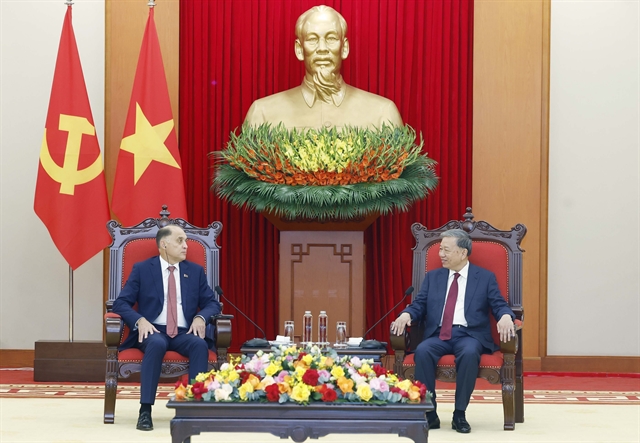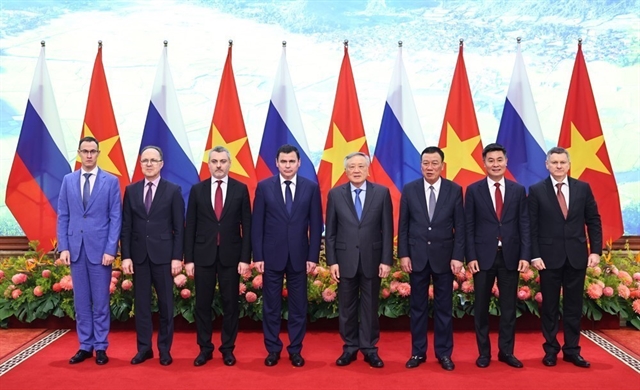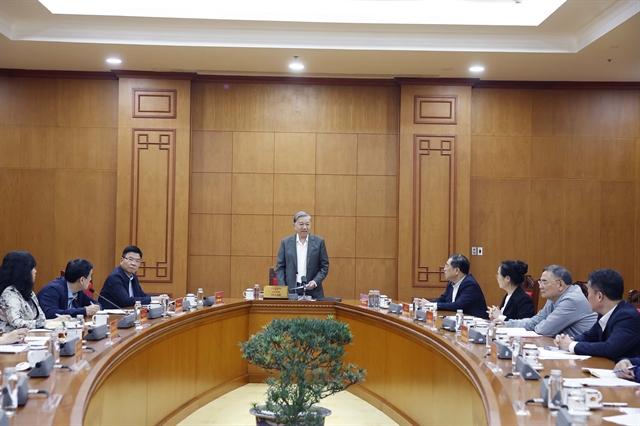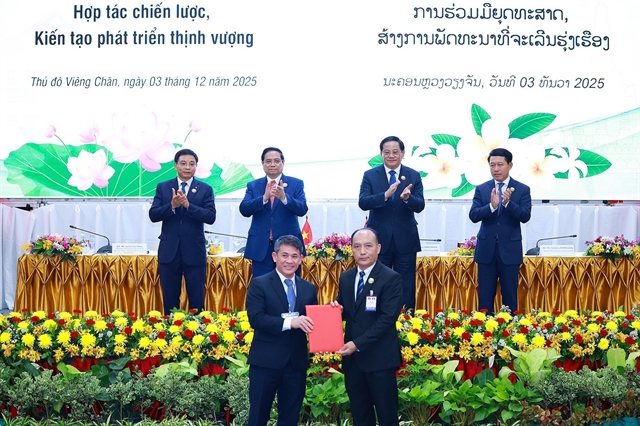 Economy
Economy
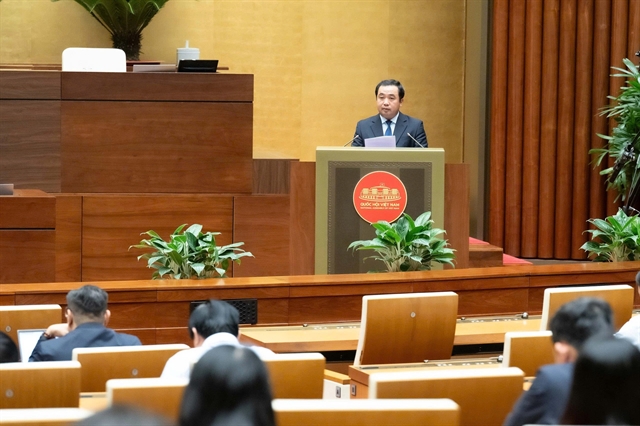
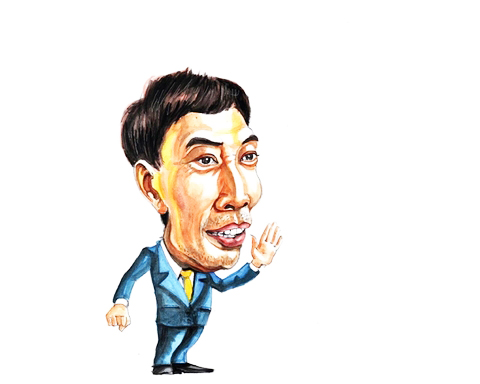 |
*Võ Trí Thành
Việt Nam’s latest economic data shows the country is on track to surpass the Government’s target of 6-6.5 per cent for GDP growth this year. However, policy actions need to maintain flexibility and caution to cope with rising external pressure.
The General Statistics Office reported positive signs were seen in most socio-economic aspects in the past nine months. The macro-economy remained stable while inflation was under control, major balances were ensured and monetary and fiscal policies were implemented in a proactive, flexible and effective manner.
Gross domestic product (GDP) rose 13.67 per cent in the third quarter (Q3), putting the nine-month GDP growth at 8.83 per cent, the highest in the past decade. This is a miracle rebound after a 6.02 per cent contraction a year ago when the nation shut down some factories as part of its tough pandemic control measures.
The consumer price index (CPI) increased 3.32 per cent in Q3 and 2.73 per cent in nine months.
Ending September, Việt Nam recorded an estimated trade surplus of US$6.5 billion. The State budget collection reached 94 per cent of the target, up 22 per cent from a year earlier.
The recovery momentum has continued since the end of last year, especially after Việt Nam opened its borders and revived the economy in March this year. However, it is worth noting that the growth engine during this period was exports, retail and disbursement of foreign direct investment (FDI), instead of exports and disbursement of public investment as expected by many experts.
From January-September, the country’s import-export saw a yearly rise of 15 per cent to US$558.5 billion, of which the export turnover surpassed $282 billion, up 17.3 per cent while imports reached $276 billion, up 13 per cent.
According to the Ministry of Industry and Trade, the country’s export revenue is expected to reach about $368 billion by year-end, up 9.5 per cent year-on-year and likely surpassing the targets set by both the Government and the ministry at around 8 per cent.
Meanwhile, retail sales of goods and services increased 21 per cent in nine months compared to a drop of 5 per cent in the same period of last year.
The rapid and successful control of the pandemic in Việt Nam has also strengthened foreign investors’ confidence in the country’s economy. FDI disbursement reached a five-year high of $15.43 billion, up 16.3 per cent year-on-year.
Việt Nam has achieved certain success in maintaining macroeconomic stability amid the turmoil of the international background. However, the pressure is still very great given persistent rising inflation in the world and the higher risk of “importing inflation”, especially after the US Federal Reserve (Fed) has hiked interest rates several times this year which made the US dollar appreciate compared to most other currencies and drove capital flows out of emerging countries.
This pressure has already been reflected in the inflation data which though remained relatively low but increased compared to last year. The Vietnamese đồng (VND) has also depreciated against the USD (yet low compared to other currencies). The State Bank of Việt Nam (SBV) last month also raised interest rates by 1 percentage point in face of the Fed’s hawkish rate hikes.
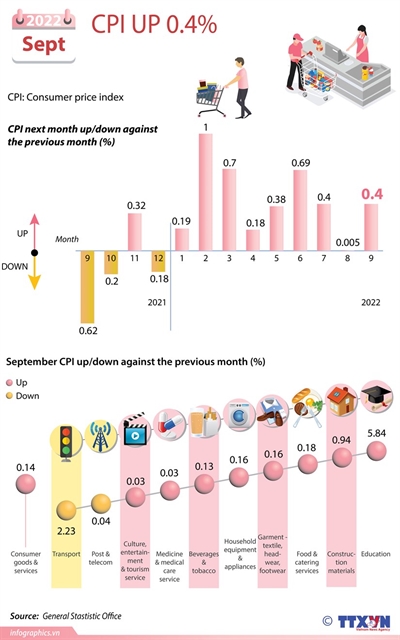 |
Recent discussions focus on how Việt Nam will direct policy in the near future, and whether its choice is different from other countries that are choosing to sacrifice growth to control inflation.
Regarding growth in the last quarter and into next year, Việt Nam’s driving forces will also face many challenges.
Exports are expected to face a slowdown due to the decline of the world economy, especially in Việt Nam’s major trading partners such as Europe, the US and China. The risk of narrowing export markets is real with export orders in many industries declining.
In its latest report last week, the World Bank slashed its economic outlook for the Asia Pacific to 3.2 per cent in 2022, down from a 5 per cent forecast in April. China’s GDP is also projected down from 5 per cent to 2.8 per cent this year.
In OECD Economic Outlook, Interim Report September 2022, global growth is projected to remain subdued in the second half of 2022, before slowing further in 2023 to annual growth of just 2.2 per cent. The US and Germany’s economies are forecast to expand just 1.5 per cent and 1.2 per cent, respectively.
With regard to the driving force related to FDI, it’s not easy to maintain the growth rate in both new investment attraction and disbursement, especially high-quality FDI due to high demand for infrastructure, green production and business conditions such as green energy, environment and living conditions for experts.
Meanwhile, retail growth was mainly driven by domestic consumption and tourism, but Q4 is the low season and travel demand next year is also expected to decrease compared to this year.
Therefore, it is no coincidence that many organisations have predicted Việt Nam would post high economic growth this year, but next year it will decrease a little bit. (World Bank’s September report forecast Việt Nam’s GDP may reach 7.2 per cent this year but will slow to 6.7 per cent in 2023.)
To maintain growth in the last quarter and next year, it’s important to take advantage of free trade agreements to diversify export markets. More importantly, it’s necessary to promote public investment disbursement and implement the economic recovery programme which is progressing slowly this year.
By September, only VNĐ60 trillion out of the total VNĐ347 trillion (about 17 per cent) was disbursed under the programme. Most conditions for implementation have been completed, so it’s crucial to quickly put them into practice to support businesses. Besides, the efforts to improve the business environment also need to continue to help attract foreign investments.
The macro-economy is under such pressures, but in spirit, the Vietnamese government will not likely change its policy direction which has been kept stable from the beginning of the year. It will continue a moderate and loose policy, and accept a certain reduction in revenues to accelerate the economic recovery and development programme.
Regarding monetary policy, it will keep the view of flexibility and caution, being reflected in the use of resources, tools and combined with fiscal policy to keep the nominal exchange rate fluctuating in an acceptable range and help curb “imported” inflation as well as sustain the country’s attraction to foreign investors.
Recently, SBV has used interest rate tools to protect the value of the đồng against the pressure of devaluation and inflation. This management is highly appreciated when the rate hike was not too large. Besides, the banking system should join hands to share burdens with businesses, refraining from raising lending rates too high and speeding up the interest rate support programme for businesses.
Việt Nam has some advantages such as a good fiscal situation and a positive budget revenue despite the implementation of tax reduction programmes. The ratio of the budget deficit and public debt to GDP is moderate at 43 per cent, quite low compared to the threshold set by the National Assembly at 60 per cent.
Amidst the volatility and uncertainty, Việt Nam's growth next year may not be as high as this year, but the country is still considered one of the best performers in the world and an attractive destination for FDI flows.
However, along with the current policy actions, efforts to reform and restructure the economy need to continue, laying a good foundation for the country’s sustainable development. VNS
*Võ Trí Thành is a former vice-president of the Central Institute for Economic Management (CIEM) and a member of the National Financial and Monetary Policy Advisory Council. The holder of a doctorate in economics from the Australian National University, Thanh mainly undertakes research and provides consultation on issues related to macroeconomic policies, trade liberalisation and international economic integration. Other areas of interest include institutional reforms and financial systems.
BOX
GDP growth to hit 8 per cent this year in base-case scenario: Official
HÀ NỘI — Việt Nam’s GDP growth will reach 8 per cent this year in the base-case scenario, provided that there will be no upheavals in the market but favourable external factors for the economy during the remaining months of the year, according to the Ministry of Planning and Investment (MPI)’s report at a routine government press briefing on Saturday.
In the worst-case scenario, the GDP will grow at 7.5 per cent, provided that many challenges and uncertainties are expected in the fourth quarter of this year, Deputy Minister Trần Quốc Phương said.
Commenting on Việt Nam’s economic outlook for 2023, he said there will be both challenges and opportunities, but the former are likely to outweigh the latter and be even tougher in the wake of inflationary pressure worldwide and a gloomy global economic outlook.
He noted that global inflation, particularly in major economies as well as Việt Nam's key partners, is unlikely to ease over the next one or two months but certainly will linger in 2023.
The official also voiced concern over other threats to the Vietnamese economy, emphasising the ongoing Russia-Ukraine crisis and non-conventional risks like storms, flooding, and epidemics.
The MPI forecast the Vietnamese economy will expand around 6.5 per cent in 2023 in a growth scenario submitted to the Government, he said.
The deputy minister also revealed that 46.7 per cent of the total public investment has been disbursed so far this year. — VNS

